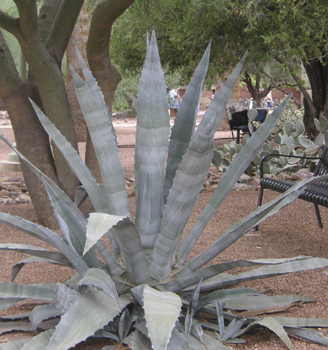American agave, century plant
Agave americana
 Agave americana is a perennial, evergreen cacti in the asparagus family. It is related to Agave tequilana, which is famous for its use in production of the popular alcoholic drink tequila. A. americana can be distinguished from its famous cousin by its wider and more green-colored lateral penca, or leaves that make up the basal rosette form. This (and most other agave species) self propagate by producing small plants called pups at the base resulting in a mounding and spreading form. One of the most striking feature of the American agave is the 10-30 foot tall flower stalk produced at maturity which emerges from the center of the basal rosette. While many believe the plant flowers every hundred years (thus, the common name of century plant), it actually blooms after 10-30 years. Each flower stalk is lined with bracts that lie flat against the stalk giving it the appearance of an enormous stalk of asparagus. The inflorescence develops from the top of the stalk where brilliant mustard yellow flowers develop. The plant is widely used to make rope from the fibrous leaves, to produce medicines, or to produce a sweet and nutritious culinary baked dish from the central portion of the agave rosette (called the “heart”).
Agave americana is a perennial, evergreen cacti in the asparagus family. It is related to Agave tequilana, which is famous for its use in production of the popular alcoholic drink tequila. A. americana can be distinguished from its famous cousin by its wider and more green-colored lateral penca, or leaves that make up the basal rosette form. This (and most other agave species) self propagate by producing small plants called pups at the base resulting in a mounding and spreading form. One of the most striking feature of the American agave is the 10-30 foot tall flower stalk produced at maturity which emerges from the center of the basal rosette. While many believe the plant flowers every hundred years (thus, the common name of century plant), it actually blooms after 10-30 years. Each flower stalk is lined with bracts that lie flat against the stalk giving it the appearance of an enormous stalk of asparagus. The inflorescence develops from the top of the stalk where brilliant mustard yellow flowers develop. The plant is widely used to make rope from the fibrous leaves, to produce medicines, or to produce a sweet and nutritious culinary baked dish from the central portion of the agave rosette (called the “heart”).
Historically, A. americana has been used within traditional medicine as an anti-inflammatory and has recently been shown to be more effective and have fewer side effects than comparable commercial drugs used for the same purpose. The sap can be used as a poultice on wounds, as an antiseptic, on bruises for faster healing, or it can be taken orally as a treatment for diarrhea, dysentery and other internal issues. Tonics made from the extracts have been known to be an effective treatment for hair loss when applied topically, and the gum from the root of the cacti can be used as a treatment for toothaches and even syphilis. A. americana leaves have also been found to be a great source for production of steroid drug precursors. In addition to the plethora of traditional medicinal uses, A. Americana is also being explored for its potential as a bioenergy crop to produce ethanol energy in arid lands.
<--- Return to: boojum
---> Proceed to: Baja poplar by walking southwest (toward Main Gate) to the Douglass Building

